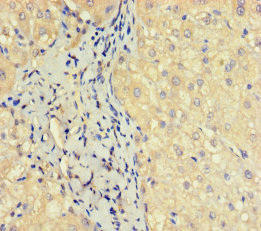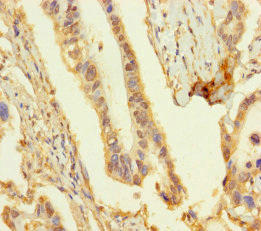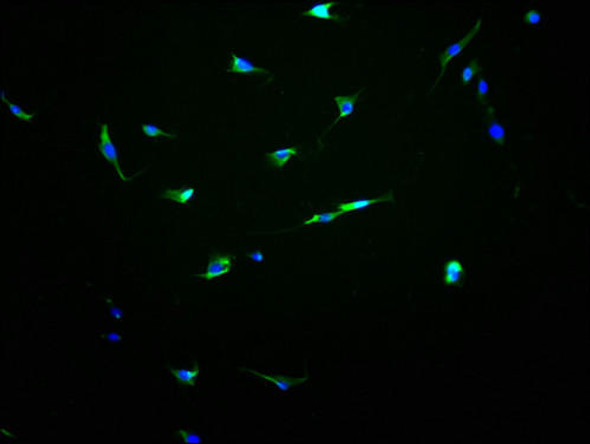Description
| Antibody Name: | OBP2A Antibody (PACO41202) |
| Antibody SKU: | PACO41202 |
| Size: | 50ug |
| Host Species: | Rabbit |
| Tested Applications: | ELISA, IHC |
| Recommended Dilutions: | ELISA:1:2000-1:10000, IHC:1:20-1:200 |
| Species Reactivity: | Human |
| Immunogen: | Recombinant Human Odorant-binding protein 2a protein (16-170AA) |
| Form: | Liquid |
| Storage Buffer: | Preservative: 0.03% Proclin 300 Constituents: 50% Glycerol, 0.01M PBS, PH 7.4 |
| Purification Method: | >95%, Protein G purified |
| Clonality: | Polyclonal |
| Isotype: | IgG |
| Conjugate: | Non-conjugated |
 | Immunohistochemistry of paraffin-embedded human liver cancer using PACO41202 at dilution of 1:100. |
 | Immunohistochemistry of paraffin-embedded human pancreatic cancer using PACO41202 at dilution of 1:100. |
| Background: | Probably binds and transports small hydrophobic volatile molecules with a higher affinity for aldehydes and large fatty acid,. |
| Synonyms: | Odorant-binding protein 2a (Odorant-binding protein IIa) (OBPIIa), OBP2A |
| UniProt Protein Function: | OBP2A: Probably binds and transports small hydrophobic volatile molecules with a higher affinity for aldehydes and large fatty acids. Belongs to the calycin superfamily. Lipocalin family. 4 isoforms of the human protein are produced by alternative splicing.Protein type: Secreted, signal peptide; SecretedChromosomal Location of Human Ortholog: 9q34Cellular Component: extracellular regionMolecular Function: odorant bindingBiological Process: sensory perception of chemical stimulus; transport; response to stimulus; sensory perception of smell |
| UniProt Protein Details: | |
| NCBI Summary: | This gene encodes a small extracellular protein belonging to the lipocalin superfamily. The protein is thought to transport small, hydrophobic, volatile molecules or odorants through the nasal mucus to olfactory receptors, and may also function as a scavenger of highly concentrated or toxic odors. The protein is expressed as a monomer in the nasal mucus, and can bind diverse types of odorants with a higher affinity for aldehydes and fatty acids. This gene and a highly similar family member are located in a cluster of lipocalin genes on chromosome 9. Alternatively spliced transcript variants have been described, but their biological validity has not been determined. [provided by RefSeq, Jul 2008] |
| UniProt Code: | Q9NY56 |
| NCBI GenInfo Identifier: | 47479498 |
| NCBI Gene ID: | 29991 |
| NCBI Accession: | AAH69563.1 |
| UniProt Secondary Accession: | Q9NY56,Q5T8A3, Q9NY50, Q9NY53, Q9NY54, Q9NY55 |
| UniProt Related Accession: | Q9NY56 |
| Molecular Weight: | 26,014 Da |
| NCBI Full Name: | Odorant binding protein 2A |
| NCBI Synonym Full Names: | odorant binding protein 2A |
| NCBI Official Symbol: | OBP2A |
| NCBI Official Synonym Symbols: | OBP; LCN13; OBP2C; OBPIIa; hOBPIIa |
| NCBI Protein Information: | odorant-binding protein 2a |
| UniProt Protein Name: | Odorant-binding protein 2a |
| UniProt Synonym Protein Names: | Odorant-binding protein IIa; OBPIIa |
| Protein Family: | Odorant-binding protein |
| UniProt Gene Name: | OBP2A |
| UniProt Entry Name: | OBP2A_HUMAN |






